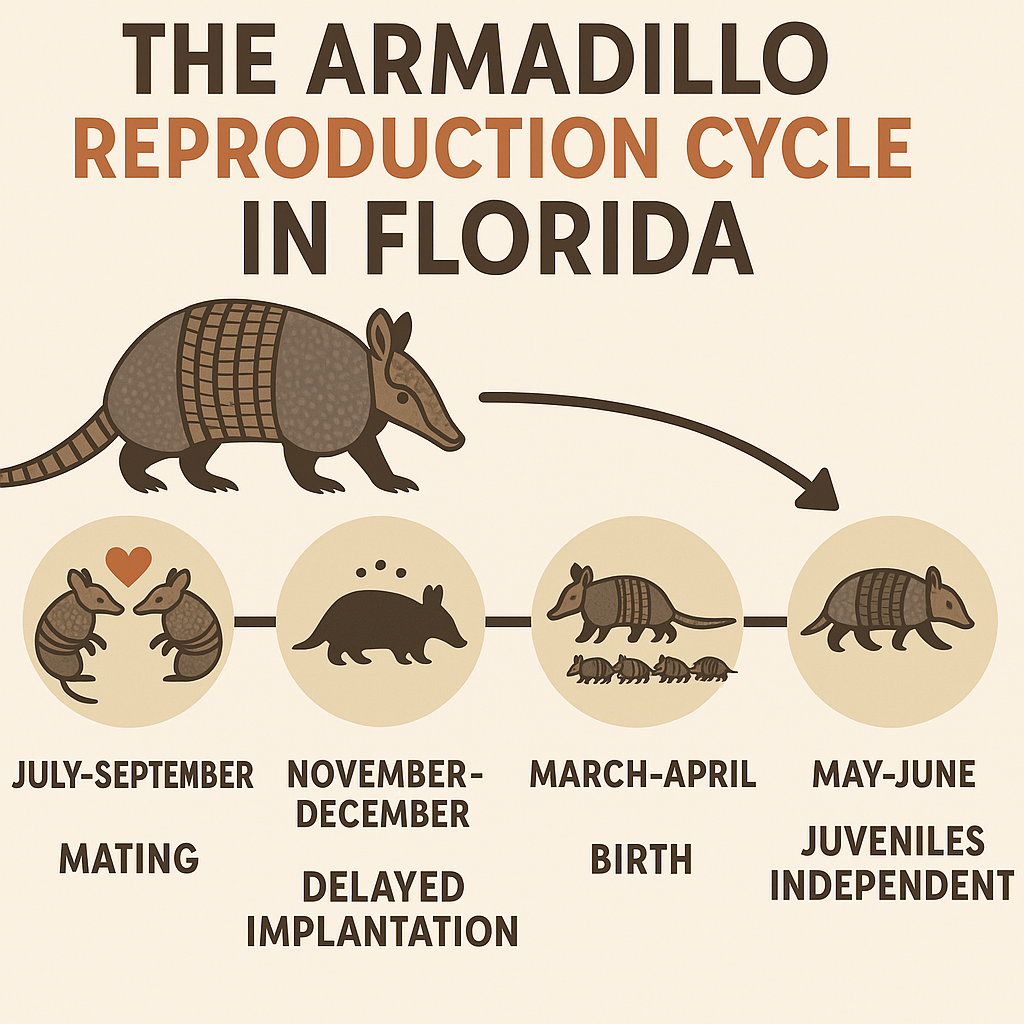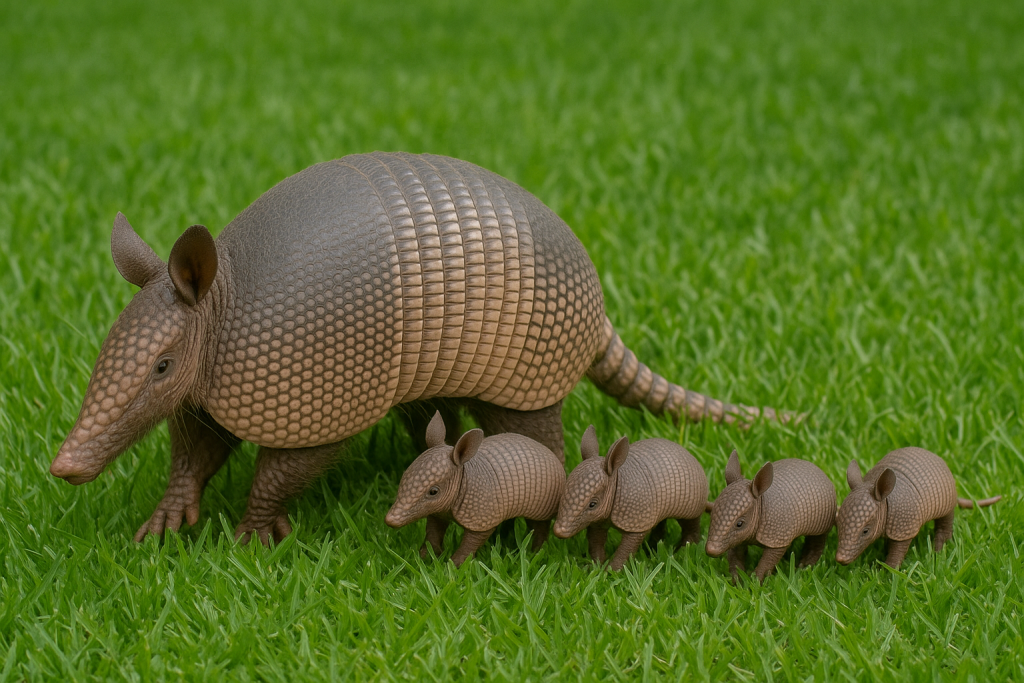Understanding the Armadillo reproduction cycle can help you determine when, why, and how to take action before it becomes an infestation.
If you live in Florida and have ever noticed your lawn being torn up overnight or mysterious holes near your foundation, you may have been introduced to the handiwork of the nine-banded armadillo. While these armor-clad diggers can be fascinating creatures, they can also become a serious nuisance—especially during their reproduction season. Understanding the reproduction cycle of armadillos in Florida is key to knowing when you’re most at risk for property damage and when it’s time to call in professionals like us at ArmadilloTrapper.com.
🐾 Florida’s Perfect Breeding Ground for Armadillos
Florida’s warm, sandy soils and subtropical climate create ideal conditions for armadillos to thrive year-round. The nine-banded armadillo (Dasypus novemcinctus), the most common species in the southeastern U.S., has adapted remarkably well to the Florida environment. And with no natural predators to keep populations in check, their numbers—and their damage—are growing fast.
📆 When Do Armadillos Reproduce?
the reproduction cycle for armadillos begins in late summer to early fall, typically between July and September. During this period, male armadillos, called boars, will begin searching for females, or sows, through scent tracking. Mating occurs shortly after the monsoon season begins, but what’s fascinating is what happens next:
Delayed implantation is a biological feature unique to armadillos. After mating, the fertilized egg doesn’t immediately implant in the uterus. Instead, implantation is delayed for up to four months, meaning actual pregnancy doesn’t begin until November or December. This allows armadillos to synchronize their birthing season with more favorable environmental conditions.

👶 Birth and Litter Size
Most armadillos give birth in March or April, just as Florida’s temperatures stabilize for spring. Each litter almost always consists of four identical quadruplets—clones that develop from a single fertilized egg. This reproductive trait makes armadillos particularly efficient at populating areas quickly.
Once born, the pups are blind, hairless, and vulnerable, but they develop quickly and are able to forage with their mother within a few weeks. By the time they are 2–3 months old, they are largely independent.

🏠 Why It Matters to Florida Homeowners
Understanding this cycle is critical because spring and early summer are when property owners start seeing signs of new activity, as juvenile armadillos venture out on their own. That means more digging, more dens, and more property damage—especially around:
- Foundations and crawl spaces
- Driveways and sidewalks
- Pool decks and irrigation systems
- Gardens and lawns
The combination of soft soil and dense vegetation makes Florida neighborhoods a magnet for these burrowing pests.
🚩 Signs of an Armadillo Den on Your Property
If you suspect armadillos are breeding on your property, look for:
- Cone-shaped holes about 1–3 inches wide in your lawn
- A larger burrow opening (around 7–10 inches wide) near your home’s foundation or under a deck
- Disrupted mulch, uprooted plants, or exposed tree roots
- Unexplained damage to pipes or irrigation systems
Left unchecked, these dens can compromise structural integrity, particularly around foundations, footings, and walkways.
🪤 Why Reproduction Season Is the Right Time to Trap
Because armadillos are territorial and prefer to stay near their burrows, reproduction season offers a unique opportunity to trap and remove them before populations spread. Trapping a mother armadillo before she births or shortly after can prevent four more armadillos from taking up residence on your property.
At ArmadilloTrapper.com, we use humane, legal, and effective trapping techniques tailored to the behavior of Florida armadillos. Our team understands seasonal patterns and den placement habits, giving us the edge in quickly identifying and solving your armadillo problem.
✅ Proactive Prevention Tips
While professional trapping is the most effective long-term solution, you can also reduce the chances of armadillos choosing your yard to raise a family by:
- Removing dense shrubbery or wood piles near your home
- Installing hardware cloth around decks or sheds
- Maintaining your lawn to eliminate insect attractants (like grubs)
- Securing trash and compost bins
- Sealing off known burrow locations with soil and rock once empty
If you’ve had armadillos before, chances are you’ll get them again—unless you act proactively.
📞 Don’t Wait Until They Multiply — Contact ArmadilloTrapper.com (941) 239-3866
Florida’s armadillo reproduction season may seem like a natural wonder, but for homeowners, it’s often a destructive nuisance. If you suspect an armadillo has made your yard its maternity ward, don’t wait until it becomes a family affair.
Contact us today at ArmadilloTrapper.com to schedule an inspection or trapping service. We proudly serve communities across Manatee, Sarasota, and Southern Hillsborough Counties, including Bradenton, Lakewood Ranch, Parrish, Riverview, and Sun City Center.
🦾 Fun Fact: The Armadillo’s Superpower
Did you know that armadillo pups are genetically identical because they come from the same egg? This makes them a fascinating subject for scientific research in cloning and genetics—but not something you want tunneling under your driveway!
